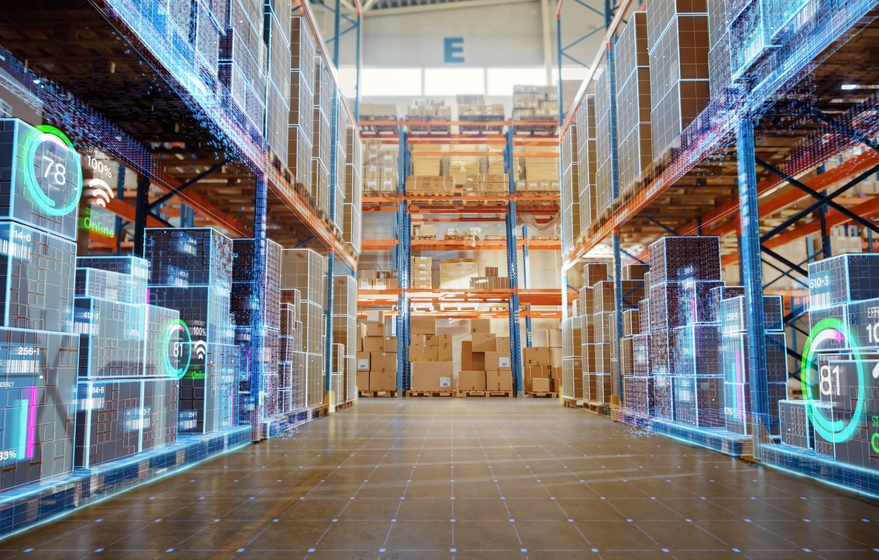Real-time Location Systems (RTLS) grew out of the warehousing and logistics industry and can now be found in auto plants, hospitals, ports, and a growing list of manufacturing environments. In warehousing, the need to track inventory has always been crucial, but modern RTLS systems are capable of much more than simply tracking the location of pallets. In this article, we will run through the main applications of Warehousing RTLS in 2023.
But first, a quick primer on RTLS:
RTLS is used to track the real-time location of vital assets, including inventory, vehicles, tools, machinery and even people. These key assets are tracked with special tags, and sensors gather the tags’ data and feed it into specialized software that helps to visualize the environment and drive both insights and automation initiatives. There are a wide variety of RTLS technologies available, ranging from the hyper-accurate to the less reliable. Ultra-wideband RTLS is becoming increasingly popular in warehousing due to its accuracy and ability to avoid interference.
Forklift fleet management
Fleets of forklifts are one of the major expenses in many warehousing environments. RTLS can help reduce the cost of running these fleets while optimizing their performance.
Optimize movement via a digital twin
By tagging each forklift, one can track the movement of all forklifts and optimize their routes, ensuring that work is carried out in the most efficient manner possible. Drivers that are choosing inefficient routes can be notified, and plans for vehicle mustering points can be modified.
Speed control/accident avoidance
By creating zones within the warehouse, one can ensure that forklifts stick to a low speed in collision-prone areas.
Only authorised personnel
RTLS can measure the proximity of vehicle tags with the tags carried by specific personnel. If unqualified personnel need to be restricted from using vehicles, the system can trigger alerts when they attempt to operate a vehicle. This kind of interaction warning can only be achieved by hyper-accurate RTLS systems, such as Ubisense’s SmartSpace®.
Maintenance/utilization
By tagging forklifts, one can rack the usage of each vehicle, and schedule maintenance tasks around usage rather than time elapsed. This can reduce overall maintenance costs while warning of possible over-usage. The system can also keep track of a vehicle’s maintenance history, reducing the need for separate paperwork.
General Inventory Tracking
Inventory/pallet management
An RTLS can increase the speed of operations and improve warehouse picking rates. Rather than passive RFID solutions, which require manual scanning, an RTLS can track exactly what’s in your facility in real time.
Smart Storage
When space is at a premium, RTLS can reduce your costs by improving the use of your floor space. Items that won’t be needed soon can be blocked in, while in-demand items are stored in optimal locations. As circumstances change, the RTLS will automatically compensate.
Storage accuracy
The key value of the more accurate RTLS systems is their ability to alert forklift drivers and managers when items are incorrectly stored. If pallets are paced in the wrong bay, they can quickly be located and moved. No more missing inventory.
Simplify reverse logistics (returns)
When items are returned by customers, the RTLS can ensure they are not mixed in with regular inventory and are processed appropriately.
Tagging and locating equipment
Tools like digital calipers and socket wrenches often go missing in warehouses, leading to staff roaming the aisles, wasting valuable time. By attaching mini-tags to these tools, one can track where items are from a phone or iPad, saving man-hours and reducing stress.
Compliance
If auditors need to see a detailed overview of what inventory is on-site, and any historical data from your facility, an RTLS can simplify this process, ensuring that proper compliance procedures are being followed at all times.
Loading/unloading trucks
As trucks arrive at a facility, one can prioritize them according to urgency, and staff will be sent to the correct loading bays in a timely fashion. By using complementary RTLS technologies, like RTK-GPS and UWB, one can create a seamless overview of how trucks are moving through the external parts of a facility and how the inventory is loaded/unloaded. Trucks will be dispatched only when the correct cargo has been loaded/unloaded.
Managing staff
Track individuals with wearables
By giving staff members tagged lanyards or wristbands, managers can simplify security measures and track when people have signed in and out of a facility. One can also utilize haptic feedback to notify staff members if they have entered a restricted area.
Assign tasks automatically
When a staff member enters a facility, they can have their daily tasks assigned automatically, making use of handheld devices. Managers will need to spend less time briefing staff and updating schedules as requirements change.
Health and Safety
The No.1 reason for tracking employees in a warehousing environment is for their own safety. Mustering areas can be created, and managers can be notified which employees are where in the event of fires or accidents. Panic buttons can be made available to staff, and alerts can be triggered when staff approach dangerous areas or fail to socially distance. In the event of an accident, managers can check who was on-site at the time and investigate the causes accordingly.
Track multiple sites
One of the key advantages of RTLS in warehousing is the ability to track multiple sites, from anywhere in the world, in real time. This can make the oversight of large warehousing and logistics operations far easier in an increasingly competitive global market.
We have looked at some of the key ways in which RTLS is benefiting warehousing facilities in 2023. However, the applications of RTLS technology are constantly expanding. If you would like to know more about what Ubisense’s SmartSpace® could do for your facility, please get in touch.

